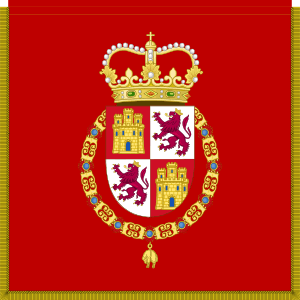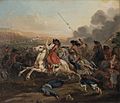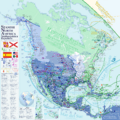Spanish colonization of the Americas facts for kids

The Spanish colonization of the Americas was when Spain started to explore, conquer, and settle lands in the Americas. This big historical event began when Christopher Columbus (Cristóbal Colón) arrived in the Americas in 1492. It was the first part of a larger movement where many European countries colonized the Americas.
Over about 400 years, Spain greatly expanded its control across the Americas. Their territories eventually included Central America, most of South America, Mexico, and large parts of what is now the United States. They even reached areas like British Columbia in Canada and Alaska. However, in the early 1800s, many Spanish colonies in the Americas began to fight for their freedom. By the mid-1820s, countries like Mexico and most of Central and South America had become independent from Spain. The last Spanish colonies, Cuba and Puerto Rico, gained their independence in 1898 after the Spanish–American War.
Images for kids
-
The Discovery Of America by Johann Moritz Rugendas.
-
A 17th-century painting showing the meeting of Hernán Cortés and the Aztec emperor Moctezuma.
-
A painting by John Everett Millais (1845) showing Francisco Pizarro capturing the Inca emperor Atahualpa.
-
A portrait of Gonzalo Jiménez de Quesada, a Spanish explorer.
-
A monument to Pedro de Mendoza in Buenos Aires, Argentina.
-
A bust of Álvar Núñez Cabeza de Vaca, who wrote about his long journey through North America.
-
The National Palace in Mexico City, built by Hernán Cortés.
-
A Mapuche person on horseback carrying off a Spanish woman, by Johann Moritz Rugendas.
-
Nicolás de Ovando, a Spanish governor sent to the Americas.
-
Fray Bartolomé de las Casas, known as the Protector of the Indians.
-
A view of the Plaza Mayor of Mexico City and the viceroy's palace, painted by Cristóbal de Villalpando in 1695.
-
Members of the Real Audiencia (Royal Court) of Lima, from the book Nueva Crónica y Buen Gobierno.
-
The Cabildo (town hall) in the city of Salta, Argentina.
-
A painting by Luis de Mena from 1750, showing the Virgin of Guadalupe and the social classes of the time.
-
A page from the Codex Mendoza showing tribute paid by a region of the Aztec Empire.
-
A painting by Pietro Gualdi from 1846, showing the silver mining process at the Hacienda Nueva de Fresnillo.
See also
 In Spanish: Colonización española de América para niños
In Spanish: Colonización española de América para niños

































